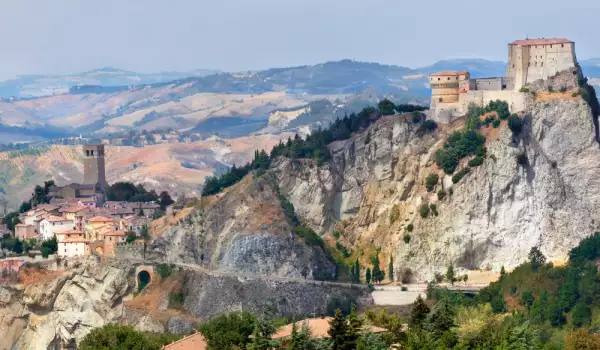San Leo

San Leo is a small medieval town situated in the valley Valmarecchia, near Rimini, in the southern part of the region Emilia Romagna, sandwiched between Tuscany, Marche and the Republic of San Marino. The medieval town stands on a huge mass of limestone and sand, complete with swirling cliffs and peaks covered with vegetation and watercourses as a result of complex and violent geological processes.
This makes San Leo a paradigmatic example of the remarkable geomorphological phenomena characteristic of Valmarecchia. Since ancient times it was a natural fortress for the majestic rock that rises almost 600 meters above sea level, San Leo now gives us a relaxing atmosphere and great views of forests, small hills scattered with houses on them, busy roads, and reaches down to the blue sea.
Its ancient city name was Montefeltrio from the Latin Mons Feretrius is related to an important Roman settlement built around a temple dedicated to the god Jupiter. Although we can not determine the exact year in which the Romans had reached this place, it can be argued that it was in the third century, the Roman fort was built on the highest point of the hill by the Romans, which considered fortress walls useless as steep cliffs make the mountain unattainable from any side.

Current name of the city is taken from St. Leon, who in the 4th century with San Marino arrived from Dalmatia (Croatia) and spread Christianity in the area. Leon is considered the first bishop of Montefeltrio, although the church, as such, is made only between the sixth and seventh century, when around the rocks formed the first residential center and between the 8th and 9th century on Roman temple rises La Pieve - the first church building, the center of town and church life. Exactly 826 years from the date the first written mention of the bishop of Montefeltrio.
In the 962-63 year, the fort falls in the hands of King Berengario by Longobardi, besieged by Ottone I, who returns the fortress to the Church as a gift from the Carolingian dynasty. The village abandons its ancient name and adopted the name Civitas Sanctis Leonis (city of St. Leon), in honor of the patron saint Saint Leo. In XII century it passed into the hands of nobles for half of the century. From 1284 to 1286, San Leo is for a short time a Free Republic, then passes from the domination of the Malatesta of Rimini, to that of their enemies Montefeltrio of Urbino.
In 1508, with the extinction of the dynasty Montefeltrio, Urbino duchy and the county of San Leo, respectively, are in the possession of Francesco Maria I, and in 1516, with Lorenzo Medici. In 1631 the Papal States to return it, using the fortress prison for possession and remained here until 1860, when he formed Kingdom of Italy and San Leo joins him. In 2006 a referendum from San Leo wants separation from the Marche region, in 2009 it is formally transferred to the Municipality of Rimini, Emilia Romagna region.
A single street runs through the small medieval town and walking on it, the visitors go several centuries back in time, surrounded by stone houses and ancient monuments and medieval palaces. The most ancient church building was erected for the Assumption in the Carolingian era and reconstructed almost entirely during the Romanism. Built entirely of stone, it contains the first tangible evidence of the Christianization of the area - the original cell, in which San Leo retreated for prayer.

The church is the Cathedral of the IX century, dedicated to the cult of St. Leon. At the beginning of 1173 (the date is carved on a column), the cathedral was entirely rebuilt in the Lombardi Romanesque-style, which we enjoy to this day.
Separated from the cathedral tower is a tower erected on a hill, probably of Byzantine origin. Built with great precision, it looks like a compact block, a natural extension of the rock on which is built an impressive manifesto of Christianity over the centuries.
On the central square of San Leo can be seen Nardini palace, in which took place the famous meeting between San Francesco d'Assisi and Count Orlando Cattani, palace Rovere, the municipal palace Mediceo, now housing the Museum of sacred art on the top floor and the bottom is for the historical archives, library and the tourist office.
Another landmark is the castle of San Leo, which rises directly on the rock with an almost miraculous balance. Since the Middle Ages, this impregnable fortress had great importance because of its strategic position. It has been the subject of meetings and bloody wars between some of the most important generals in the history of Italy. Today the castle is a museum of martial arts and is open to visitors throughout the year, while the bell tower is open only during summer season.















